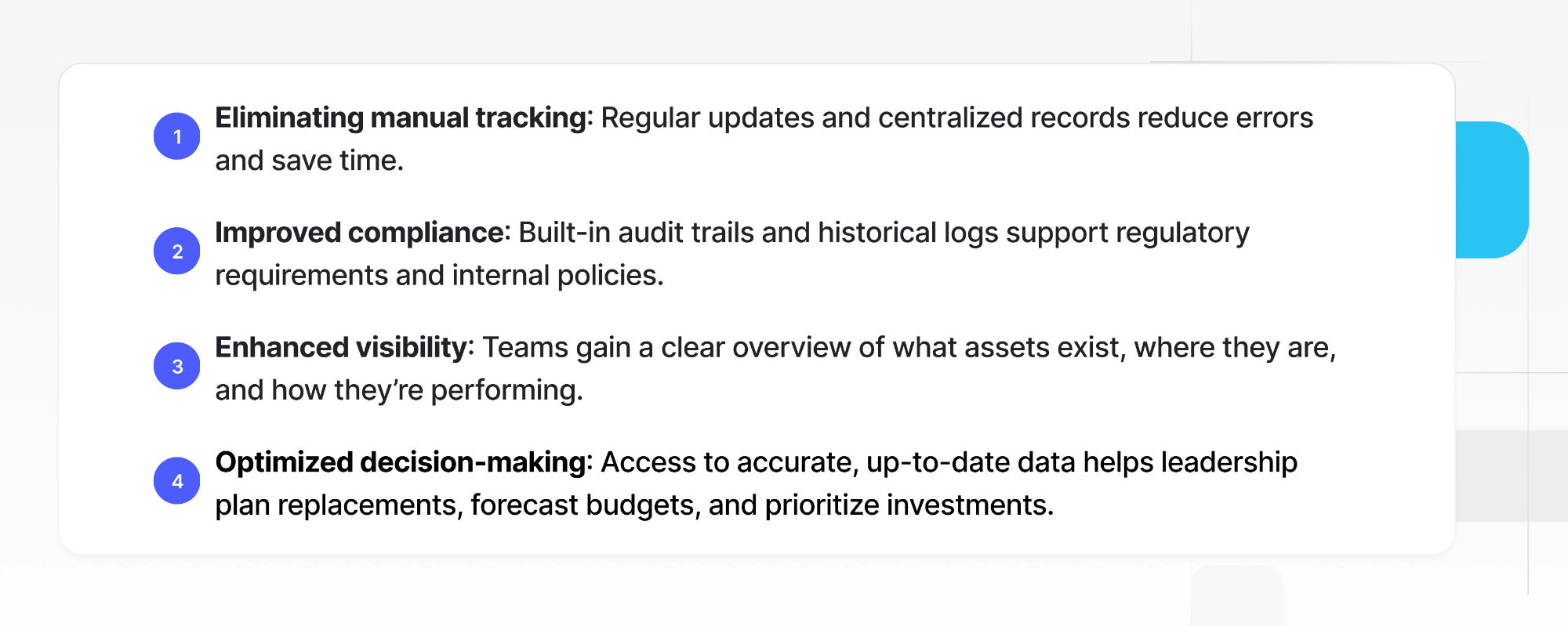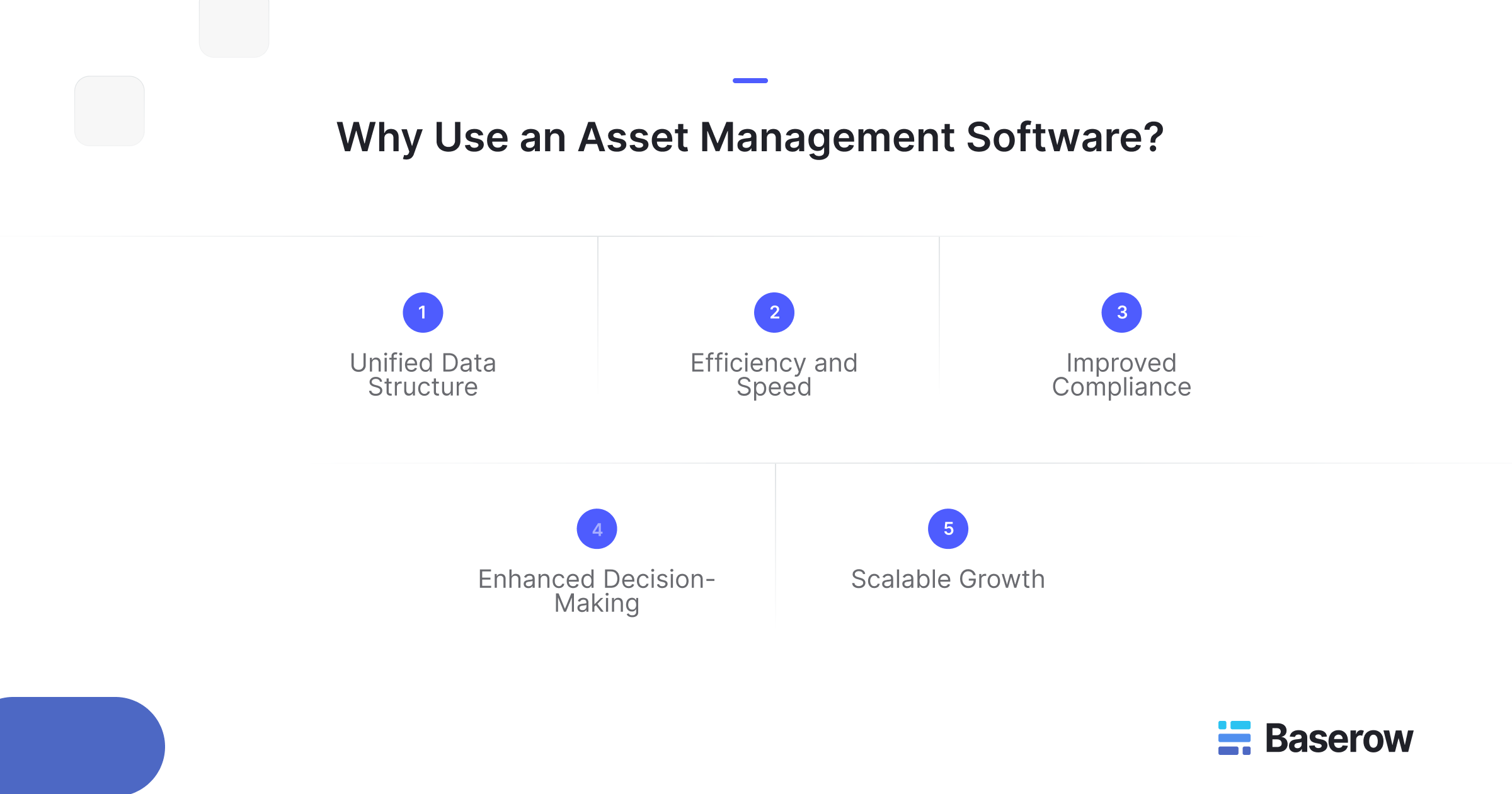
Looking to gain full visibility and control over your business assets? Effective asset management goes far beyond tracking serial numbers in spreadsheets. It’s about building a clear, connected system that keeps every asset — from office laptops to software licenses — visible, secure, and performing at its best.
In this article, we’ll break down what asset management really means, explore the benefits of using modern Asset Management Software, and show you how a flexible template can transform your approach. Whether you’re a small team or a global organization, the right asset management solution empowers you to manage assets smarter and make faster, data-driven decisions.
Discover why teams choose Baserow’s user-friendly, no-code platform to bring order and clarity to asset management.
What is Asset Management?
At its core, asset management is the organized process of tracking and optimizing everything a company owns. This can include physical items like laptops and machinery, as well as digital resources such as software licenses, cloud accounts, and media files.
Many businesses start by manually tracking these items in spreadsheets. While this might work for small inventories, it quickly becomes unmanageable as the organization grows. Errors, outdated information, and missing assets become common — leading to unexpected costs and compliance risks.
A strong asset management process ensures each asset is documented, maintained, and used effectively throughout its lifecycle. It supports budget planning, risk management, and strategic decision-making across departments.
What is Asset Management Software?
Asset Management Software is a powerful tool designed to centralize and automate the tracking of all business assets in one system. Instead of maintaining fragmented spreadsheets and relying on manual updates, organizations can use software to keep their asset data current, accurate, and accessible in real time.
This type of software helps businesses categorize assets, assign ownership, track statuses, and store essential details like purchase dates, warranty information, and service records. By providing a single source of truth, asset management systems help reduce operational risks and improve overall efficiency.
Key benefits of using a dedicated software solution include:

Whether you’re managing software licensing for a SaaS product or tracking physical equipment across multiple sites, asset management software supports a more strategic approach to resource management.
Key Capabilities of Asset Management Software
Modern asset management software isn’t just about listing items — it’s about creating a dynamic system that adapts to your business. Here’s what you can expect from a robust solution:
- Detailed asset categorization: Classify your assets into logical groups such as IT hardware, office furniture, or software subscriptions.
- Ownership and responsibility: Clearly assign assets to individuals or departments to improve accountability and minimize loss.
- Status tracking: Monitor whether an asset is active, under repair, in storage, or retired, all at a glance.
- Priority and lifecycle management: Flag high-priority items and track their lifecycle stages to plan maintenance or replacements.
- Audit-ready logs: Maintain complete histories of edits and changes for strong governance and compliance readiness.
- Document storage: Attach invoices, warranty files, and service records directly to asset entries for easy access.
When powered by a flexible management platform like Baserow, these capabilities become even more valuable. You can customize fields to match your specific workflows, create custom views for different teams, and adapt your system without the need for coding or IT support.
This flexibility is particularly important for businesses managing complex environments, where assets range from on-premise equipment to virtual resources in the cloud. By consolidating all this information into a single platform, you can reduce inefficiencies and support strategic growth.
Use Cases Across Different Asset Types
Every business handles a diverse range of assets — from laptops and mobile devices to software subscriptions and large-scale machinery. The template is designed to cover all these scenarios while remaining customizable for your unique needs.
🔸 IT and Software Assets
When it comes to software licenses and IT hardware, accuracy is critical. Using an asset management system to monitor who is using what, license renewal dates, and compliance requirements prevents overspending and unlicensed usage. You can even integrate asset tracking features that alert you before licenses expire, or when hardware is due for replacement.
🔸 Office and Fixed Assets
For companies with large office spaces or remote teams, managing physical items like desks, monitors, and ergonomic equipment can become complex. A central platform simplifies tracking by maintaining details about purchase dates, locations, and service schedules — no more digging through old records.
🔸 Digital and Cloud-Based Assets
Modern organizations rely heavily on digital assets stored across various cloud technologies. With a dedicated template, teams can catalog brand files, marketing visuals, and confidential documents in one place, reducing duplication and ensuring consistent branding.
🔸 Enterprise and Large-Scale Assets
In larger enterprises, asset tracking often spans multiple locations, departments, and budgets. An asset management solution streamlines oversight, enabling teams to see the big picture while drilling down to specific sites or asset categories.
Why Use Asset Management Software?
A dedicated Asset Management Software solution provides critical advantages that manual methods or basic spreadsheets can’t match.

- Unified Data Structure
Instead of scattered files and individual department lists, software consolidates all data into one central, easily accessible location. This unified approach reduces confusion and improves collaboration.
- Efficiency and Speed
Manual updates are time-consuming and prone to errors. With software, teams can update records in real time, generate reports instantly, and automate recurring tasks. This saves hours of administrative work and allows staff to focus on higher-value activities.
- Improved Compliance
Many industries require strict asset tracking for regulatory or audit purposes. Software with integrated audit trails and role-based permissions ensures that you can provide complete histories of asset movements and changes when needed, supporting strong compliance.
- Enhanced Decision-Making
When leadership has access to accurate, up-to-date information, they can make smarter choices about asset replacement, scaling operations, and budgeting. You no longer rely on assumptions or outdated records — decisions are data-driven and defensible.
- Scalable Growth
As your business expands, so does your asset inventory. Unlike static spreadsheets, asset management systems are designed to scale. Whether you’re managing 100 items or 10,000, the software adapts without sacrificing clarity or performance.
If you’d like a visual summary, the graphic you shared — “Why Use an Asset Management Software Template?” — beautifully illustrates these core benefits and can easily be adapted without mentioning templates.
Supporting Cloud-First and Distributed Teams
Today’s businesses operate in increasingly flexible, hybrid, and distributed models. Teams work across different locations, often relying on cloud technologies to stay connected and productive.
Baserow’s Asset Management Software is built to support this modern way of working. As a cloud-first platform, it allows team members to view and update asset data from anywhere using a web browser. While Baserow doesn’t have a native mobile app, its responsive design works well on mobile devices when quick updates are needed.
This ensures that whether your staff is on-site, working remotely, or moving between locations, they have the tools they need to keep asset data accurate and up to date. Integrations with other business systems — such as IT service management platforms or budget approval workflows — help build a seamless ecosystem, further reducing friction and manual work.
Why Choose Baserow as Your Asset Management Solution
Baserow stands out as an adaptable, no-code asset management solution designed to meet diverse business needs. Rather than offering a rigid, one-size-fits-all product, Baserow empowers organizations to create custom workflows and data structures that truly match their operations.
Key advantages include:
- Customizable fields and views: Tailor your asset data to match your business structure without developer support.
- Role-based permissions: Control who can edit, view, or manage assets, supporting security and data integrity.
- Real-time collaboration: Teams can work together seamlessly, seeing updates as they happen.
- Cloud-first accessibility: Easily manage assets from any location without on-premise limitations.
- Scalability: From small teams to enterprises managing global assets, Baserow adapts without slowing down.
For organizations comparing alternatives, Baserow offers a more flexible, modern alternative to traditional systems like Asset Panda. You don’t have to pay for rigid modules or deal with hidden limitations. With Baserow, you build a system that supports your exact workflows and priorities.
Plus, you can try it free for 14 days to see how it fits into your operations without any risk.
Move Beyond Manually Tracking Assets
Many organizations start out manually tracking assets using spreadsheets or paper logs. While this works temporarily, it can’t keep up with growing demands and increasing asset complexity.
Modern asset management software simplifies these workflows. You can automate reminders for maintenance schedules, renewal alerts for software licenses, or even budget approvals for new purchases. By moving away from manual tracking, you save time, reduce errors, and free your team to focus on higher-value work.
Using a user-friendly platform like Baserow ensures that even non-technical team members can adapt quickly. No specialized IT training, no confusing setups — just a clear interface designed to make asset oversight intuitive.
The Value of a Flexible Management Platform
Many asset management systems are rigid, built for specific industries or processes. While that works for some, most organizations need an adaptable foundation that grows with them.
A flexible management platform like Baserow allows you to:
- Adjust fields and workflows without developer help.
- Scale from a few hundred to thousands of assets.
- Integrate seamlessly with cloud technologies and existing software.
- Provide different views for different stakeholders, from finance to IT to operations.
A modular platform also supports various asset types beyond hardware and software — such as creative content, real estate, or specialized tools. By adapting to your business rather than forcing you into a rigid mold, it becomes a long-term solution rather than a temporary fix.
Get Started Today
Ready to elevate your asset strategy? Stop manually tracking and start using a modern, user-friendly solution designed for real-world challenges.
Want to learn more before you jump in? 👉 Explore Baserow’s Asset Management Solution for a deeper look at features, use cases, and how it can support your business at every stage.
Or sign up and start customizing right now!

Baserow 2.0 introduces the automations builder, upgraded AI fields, the Kuma AI assistant, enhanced workflow logic with formulas and variables, improved workspace search, and stronger security with 2FA.

Discover how Airtable and Baserow compare in features, flexibility, speed, and scalability. Compare pricing plans and hidden costs to make an informed decision!

Explore the best open-source software alternatives to proprietary products. Discover OSS tools, licenses, and use cases with our updated directory.